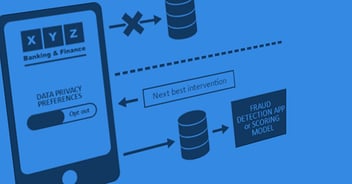The passing of data privacy legislation such as GDPR and CCPA has provided a lucrative opportunity for fraudsters, which could cost organizations and their customers millions. Because these regulations make it difficult for organizations to capture data from customers who do not provide consent, many fraudsters are able to evade detection simply by opting out of data capture. Legitimate Interest data capture provides a simple yet effective means of overcoming this challenge.
Anyone with an interest in data privacy and GDPR compliance, will be familiar with the term legitimate interest. For those less familiar, it’s one of the six lawful bases for processing customer data, meaning organizations can capture and process customer data provided they can demonstrate they're doing so to fulfill a contract or other legal or compliance obligations. Often this boils down to the processing taking place for the protection of the individual or the organization, or some other related benefit. When it comes to fraud, tracking anomalies and detecting fraudulent behavior definitely fall on the compliance side of the scale.
But many organizations interpret legitimate interest incorrectly and are using it as a basis to capture data from non-consenting visitors to their digital channels for marketing purposes. Enterprise financial institutions know better than to mix the customer data they capture for marketing purposes and the data they capture for true legitimate interest. These are organizations who are under the most scrutiny from regulators and must be able to show that consent was provided for any data used for marketing. They must also ensure marketing teams don’t have access to data collected for any other purpose. Unfortunately, with many data capture solutions this isn’t possible.
Capturing data for different purposes and dynamically managing the separation of this data is a significant challenge. As a result, many organizations only capture from opted-in visitors, meaning they’re losing out on valuable interaction data which could be used to detect fraud.
The need to compliantly capture an unparalleled level of detail from non-opted in visitors is critical for organizations to detect and prevent fraud in real-time. But they also need to do so in a compliant and ethical manner. Legitimate interest capture enables organizations to easily manage the capture of this data alongside their marketing data. With a first-party data capture solution, companies can capture all customer behavior, for every visitor to one of their digital properties, regardless of the channel. Legitimate interest capture enables signals of fraudulent activity to be identified within milliseconds and connects this data to enterprise systems that can prevent the fraudulent behavior from taking place before any loss has occurred.
With minimal configuration, this data can be captured in parallel data streams. One collects the behavioral data the company has consent to capture, compliantly using it for marketing purposes. The other captures legitimate interest data that’s only used for fraud detection. By maintaining two separate and distinct datasets, organizations can identify signals of fraudulent activity in milliseconds, while maintaining consent and regulatory compliance the entire time. Now that the data contamination issue is resolved, organizations can leverage the power of the fraud data platform to limit fraud loss by detecting signs of fraud before it occurs.
The power of this real-time fraud prevention strategy is in actively preventing fraud while supporting the customer experience by reducing friction. Reducing false positives is a big part of this. This means knowing who your customers are…and who they’re not. Much like in marketing personalization, having the right data, in the right place, at the right time is the path to success.
The right data
Behavioral data is becoming increasingly critical with more and more fraud utilizing digital devices (think mule account opening, remote account takeover (RAT), or authorized push payment fraud). As a result, fraud management teams need to see the details of each transaction -- and the behaviors displayed by the end-user around that transaction -- to identify whether it’s suspicious or genuine. With a comprehensive fraud data platform, organizations can capture the right data, including first-party, individual profiles, PII for legitimate interest where required, and behavioral biometrics, across multiple channels, devices, and domains over time. This informs the creation of comprehensive identity graphs to assist with identifying evolving threats.
The right place
The right data is useless if you can’t access it – your fraud data capture solution must deliver these insights directly into your existing fraud decisioning, case management, analytics, and reporting systems. For most banks and financial institutions, this means connecting seamlessly with multiple systems. With tight controls on data and increasing regulation, the only solution capable of delivering is a true first-party data capture solution that lives within the walls of the organization and eliminates data silos.
The right time
The only time for fraud prevention is real-time. Real-time, continuous behavioral biometrics and insights from across digital channels enhances fraud management systems and takes fraud prevention to a whole new level. If it’s not instantly available for decisioning and actioning, the best data in the world is worthless. In short, real-time data means organizations will catch more fraudsters, identify them earlier, and keep their customers happy.
For organizations trying to stay one step ahead of fraudsters, it's essential to leverage behavioral data alongside existing fraud decisioning tools. By collecting and analyzing the details around each transaction, as well as user behaviors in real-time, fraud teams are empowered to spot suspicious activity before any fraudulent damage is done.
Leveraging real-time legitimate interest data capture to deliver insight to existing decisioning, case management, analytics, and reporting solutions in milliseconds means that while the organization is serving up real-time, personalized customer experiences to their opted-in users at an individual level, in the background they're also protecting their customers and themselves from fraud.







